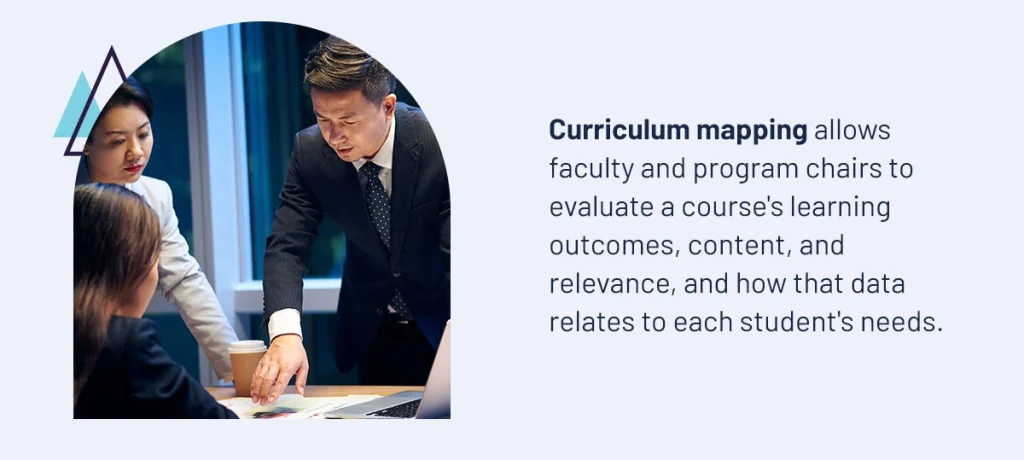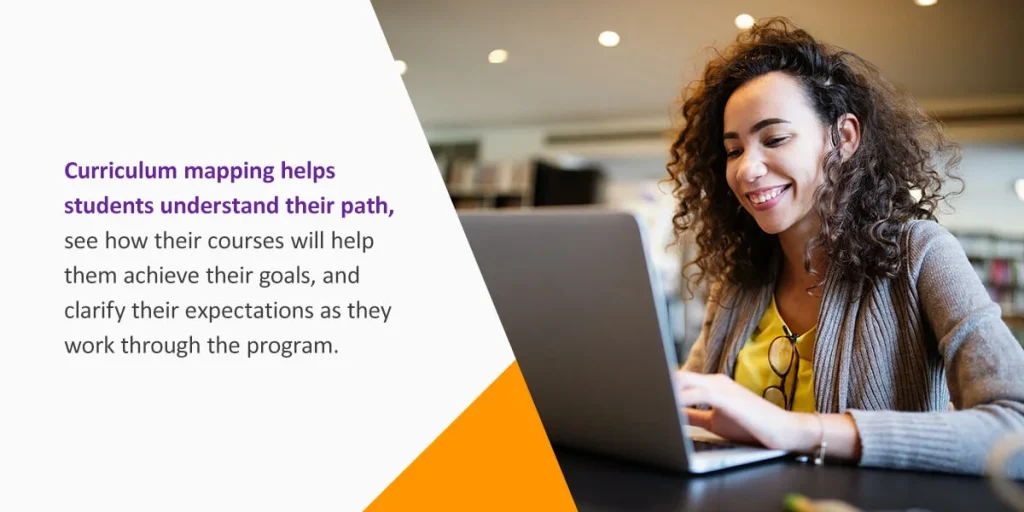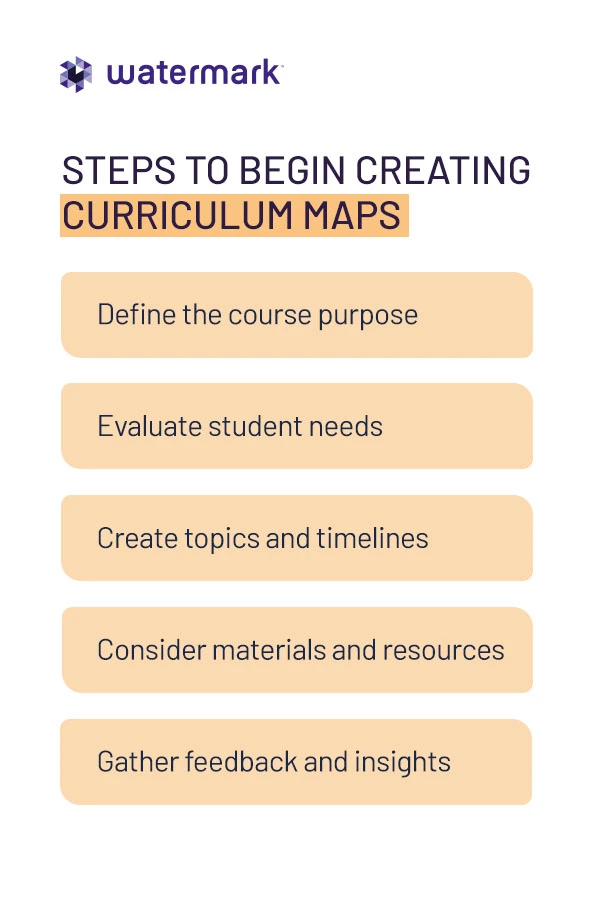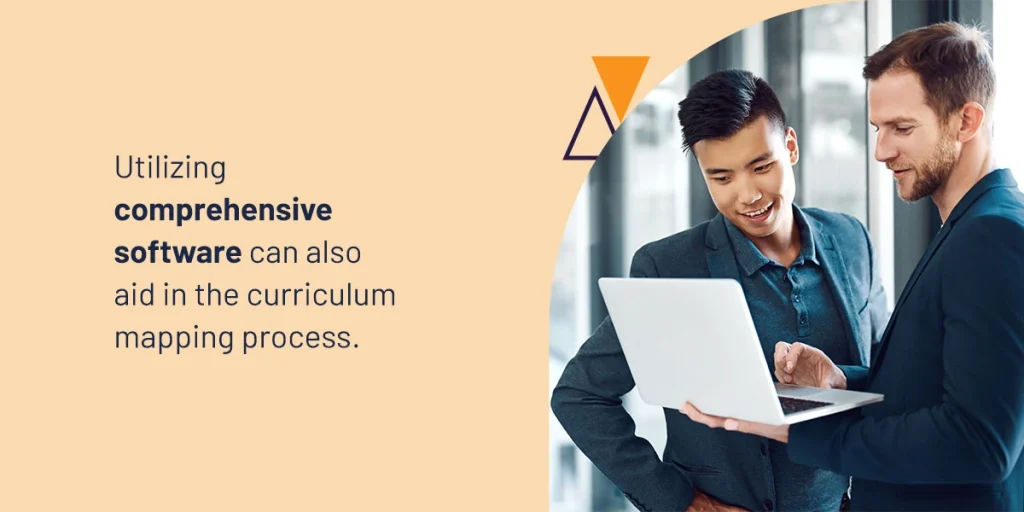




Assessing learning outcomes is critical in higher education, helping educators and administrators answer questions about what skills and content students have learned and what they must master before meeting their educational goals. Yet, having the data and insights to find these answers can be difficult without a plan for measuring learning and outcomes.
Curriculum mapping in education is a key part of the assessment process, offering valuable insights into each program’s ability to deliver specific outcomes. Curriculum mapping is a method of showing the connections between the expected outcomes of an academic program and the specific courses where this learning takes place. Learn more about curriculum mapping and how your higher education institution can utilize the process to help students achieve success.
Curriculum mapping is a process where the educators, administrators, and support staff at an institution develop an outline for teaching and assessing learning outcomes throughout the student learning journey. As part of curriculum mapping, educators create learning goals and set the scope and progression of learning across courses and degree programs. They also use curriculum mapping to measure classroom progress and guide future curriculums.
The curriculum mapping process results in a document called a curriculum map that educators can use to assess what and how they will teach content in the classroom. A curriculum map typically looks like a grid or table and provides clear insight into the outcomes students have achieved — and where they should go next. A curriculum map may cover an entire school year. The process guides faculty and students throughout the educational experience.
Curriculum mapping is about taking a long view of a student’s educational journey and ensuring that learning outcomes align with what educators teach in the classroom. This tool encourages educators to reflect frequently on learning progress and use data to meet the needs of each student. Ultimately, curriculum mapping lays a strong foundation for your assessment process so that you know where to look when it comes time to report on progress.
Why map learning outcomes to courses? There are quite a few objectives of a well-defined curriculum mapping process:
If you are wondering why you need to develop a curriculum grid, take a look at these key benefits of curriculum mapping for your higher education institution:
Curriculum mapping supports students as they learn by fostering collaboration between faculty as they create a student-first curriculum. Educators can pool their resources and work together to ensure that students meet expected learning outcomes at the right time before moving on in the program. Curriculum maps close gaps in a program’s curriculum to help students build on their knowledge properly. A curriculum map can also connect degree programs to occupations, helping students turn their skills into careers.
A curriculum map provides signposts for educators and faculty to help them determine how effective their courses were at meeting specific learning objectives. After a course is complete and faculty have assessed learning outcomes, they can compare what they actually taught in the classroom and what learning outcomes students achieved against the curriculum map. When using information this way, a curriculum map is an effective tool for helping faculty understand where learning gaps occur so they can adjust their methods.
The curriculum mapping process also helps faculty and program chairs better understand how their given course fits into the big picture of each student’s educational experiences and define expectations for student growth as they take additional courses. By outlining outcomes introduced in one class and then reinforced in a later advanced course, you can ensure students develop their knowledge and skills across the curriculum.

Curriculum mapping also helps faculty identify what students should learn in each course. Faculty can create clear objectives for their courses to help with course planning and keep the course on track while in process. Clear objectives also help students understand what they’ll learn or be able to do after completing the course. Setting clear course objectives is also necessary for analyzing whether the course does what you intended it to do and measuring student outcomes.
Curriculum mapping allows faculty and program chairs to evaluate a course’s learning outcomes, content, and relevance, and how that data relates to each student’s needs. Since reporting and tracking such data is ongoing, curriculum mapping helps simplify and make these tasks consistent. For example, faculty can use reports on curriculum data to track the impact a course has on student achievement.
In addition, academic chairs can confirm that staff members are teaching outcomes throughout the program, while faculty can take more responsibility for teaching a specific outcome.
Curriculum maps increase collaboration between faculty and staff within a department, which can help educators make the most efficient use of their and each student’s time. With a clear goal for the learning outcomes students should achieve in each class, educators can eliminate redundancies and learning gaps in their courses and across degree programs, ensuring that future course material connects to past learning.
As faculty measure what they taught against the planned curriculum and complete curriculum maps year after year, they see how their courses change over time and become better at planning lessons that meet learning outcomes.

Keeping students engaged in their learning gives them a sense of purpose, direction, and stake in their education. Curriculum mapping helps students understand their path, see how their courses will help them achieve their goals, and clarify their expectations as they work through the program. For example, visualizing a course’s objectives helps students make connections and know what to expect from the course.
With increased clarity of the curriculum path they’re on, students can take ownership of their education and make deeper connections between courses in the curriculum.
If your institution seeks accreditation status or reaffirmation, curriculum mapping helps prove that your faculty and institution are planning, implementing, assessing, and improving curriculum procedures. Curriculum mapping practices contribute to many accreditation processes. Accreditation agencies often require consistent proof that an institution is meeting curriculum benchmarks, as this demonstrates the drive for student success.
You may also need to meet state and national guidelines for educational standards, which curriculum mapping can help you report on and comply with.
Curriculum mapping is inherently collaborative. Since various courses, often taught by different faculty members, build on one another and relate to each other, faculty members can work together to create relevant curriculum maps across a program. Collaborating on curriculum maps ensures the courses in a program align with the program’s goals and create a cohesive educational experience for students. Leveraging collaboration during curriculum mapping also strengthens your faculty and creates an overall collaborative culture.
The curriculum mapping process should be intentional and focused on keeping track of what students have learned and what comes next. Your unique mapping process may look slightly different as you determine what works best for your institution and students, but you can follow these steps to begin creating curriculum maps:

The webinar Assessment Foundations: Curriculum Mapping explains how to simplify your curriculum mapping process. These tips for introducing curriculum mapping to your degree program or institution can also help you improve the process:
While curriculum mapping may produce different results across degree programs, departments, and higher education institutions, the process for each will look similar. When an institution creates a curriculum map for a degree program, the educators, department heads, and other staff involved in the program work together to develop a set of learning outcomes students should achieve. The next step is determining where educators will introduce, reinforce, and assess those outcomes.
To create a curriculum map, the educators and administrators make a table with all the courses in the program. They then determine where to teach and assess each learning outcome. The result is a graph or table educators can use to determine in which courses students should master specific concepts. Educators and administrators may then refer back to the curriculum map when creating lesson plans, evaluating the results of exams and course evaluations, and completing any other curriculum planning.
An example of a curriculum map could look like:
Course Objective 1 Objective 2 Objective 3 Objective 4
101 x x
201 x x x
202 x x x
203 x x x
The above table and the following objectives create a concise overview of which courses in a program will address which objectives and where there will be overlap for students to draw on previous experiences. Instructors and administrators can refer to this table for content creation and use the information to collaborate with others in the department to create a comprehensive and valuable educational program.

Utilizing comprehensive software can also aid in the curriculum mapping process. For example, the University of Northern Colorado simplified the curriculum process by digitizing management and workflows. This solution allowed for streamlined data entry and made insights transparent to stakeholders, allowing them to track progress on curriculum changes and more.
Your institution’s curriculum and catalogs say a lot about its goals and objectives. Watermark can empower the faculty and staff at your higher education institution to take control of the curriculum mapping process. With Watermark Curriculum Strategy, faculty can upload lesson plans, activities, resources, and other materials to the platform so others can compare curriculum maps. As a result, educators can collaborate to create course catalogs and handbooks for the courses at your institution.
Here are a few ways Watermark Curriculum Strategy helps higher education institutions with curriculum mapping:
Implementing curriculum mapping at your higher education institution is well worth the effort. A curriculum map can keep your institution and students on track with learning achievements, making it easier for faculty and educators to coordinate a curriculum that advances student outcomes.
When your institution is ready to take charge of the curriculum mapping process, Watermark Curriculum Strategy can help. The comprehensive platform allows educators to streamline collaboration and create accessible curriculum maps to connect institutional offerings to the futures of their students. To see our solutions in action, request a demo today.






























































































































































































































































































































































































Submit this form to schedule a meeting with one of our reps to learn more about our solutions. If you need customer support instead, click here.